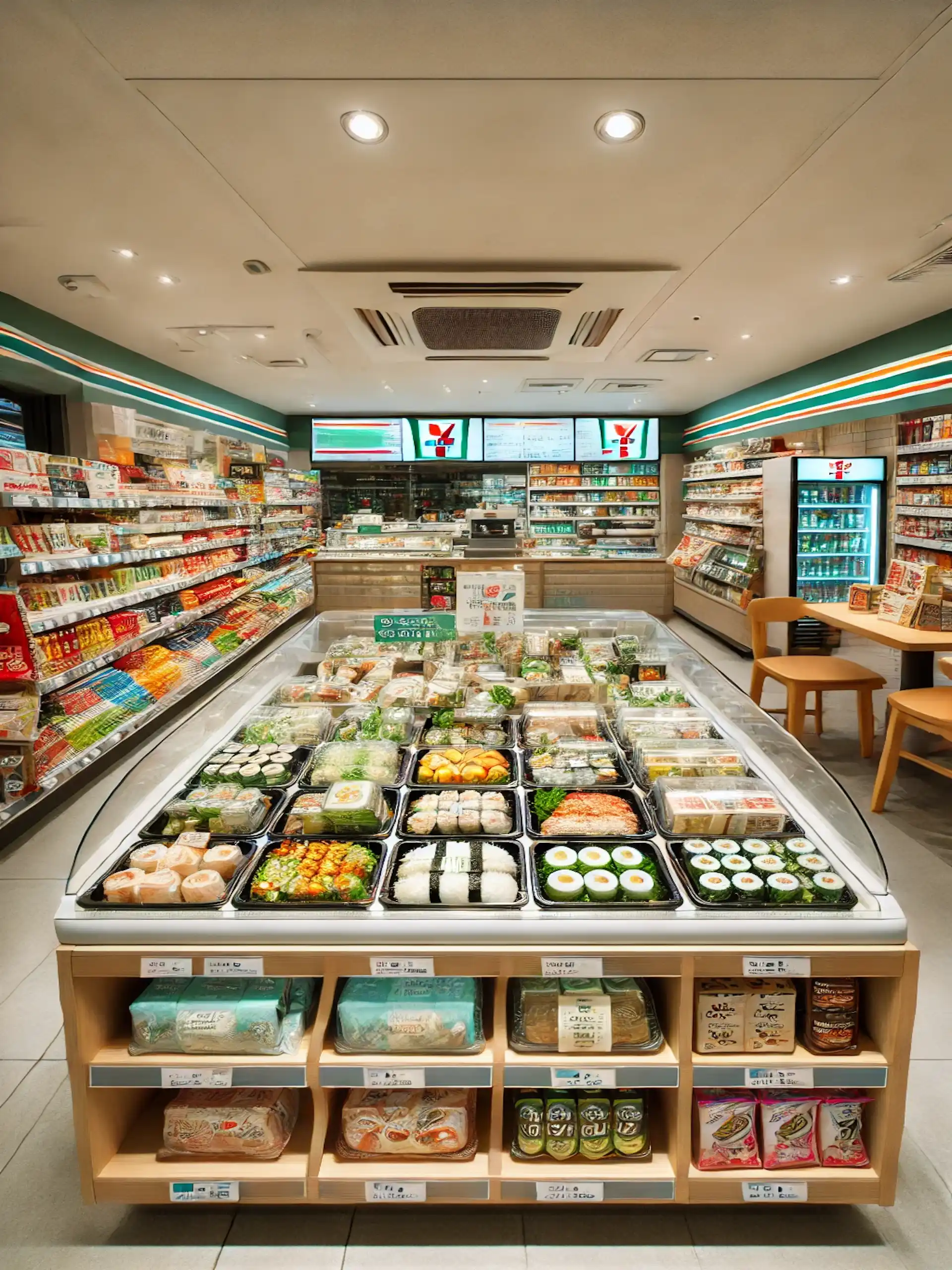|
Getting your Trinity Audio player ready...
|
7-Eleven, a store synonymous with convenience, has a unique presence in different parts of the world. While I know American 7-Eleven stores for their slurpees, pizza, fried chicken, and hot dogs, I’ve discovered that their Asian counterparts have carved a niche as popular destinations for travelers and locals. I love their fresh and unique rice and noodle dishes, which make them stand out over Western fast food chains like McDonald’s or Burger King. Now, these Asian 7-Eleven stores are coming to America, bringing their exceptional food offerings and setting a new standard for convenience stores.

Table of Contents
- Overcoming Financial Hurdles
- American 7-Eleven Stores
- Asian 7-Eleven Stores: A Haven for Food Lovers
- Bridging the Gap
- The Future of 7-Eleven
- Like it! Pin it!
Overcoming Financial Hurdles
Despite its current success, 7-Eleven has faced significant financial challenges in the past. The company went bankrupt twice: once in 1932 during the Great Depression and again in 1990 due to debt struggles. These challenges led to major restructuring and changes in ownership.
7-Eleven is now owned by Seven & I Holdings, a Japanese company that obtained a majority stake through Ito Yokado, a popular Japanese supermarket chain. This ownership has brought significant changes and improvements, the latest of which aims to align American 7-Eleven stores more closely with their successful Japanese counterparts. And that’s why Asian Seven Eleven’s are coming to America.

American 7-Eleven Stores
In the United States, 7-Eleven stores are generally larger and more expensive compared to their international counterparts and are frequently found attached to gas stations. They provide convenience for customers who can fuel up their vehicles and shop for essentials in one stop. However, you do pay extra for the convenience in a “convenience store”. With more than 9,000 locations across the country, neighborhood stores provide a one-stop shop for many urban and suburban neighborhoods. It is even more popular in Asia. My favorite country, Thailand, has 14,000 of them. In Bangkok, I saw three of them from one vantage point simply by turning my head. Here in America, they offer a variety of items, including:
- Slurpees: A frozen drink that has become a cultural icon.
- Pizza, Fried Chicken, and Hot Dogs: Quick and convenient meal options.
- Cigarettes and Gas: Traditional revenue sources, though these are declining.
However, with changing consumer habits, a decline in cigarette sales, and potential future declines in gas sales, 7-Eleven is shifting its focus toward food. This is even more important because many stores in urban areas do not sell gasoline. Ultimately inspired by their Japanese counterparts, American 7-Eleven stores are starting to embrace a more data-driven approach to stocking items. They now make daily orders based on detailed sales data, ensuring that they meet the specific needs of their customers. This means that stores in the Midwest will sell different items than in the country’s East, West, or Southern parts.

Asian 7-Eleven Stores: A Haven for Food Lovers
I’ve found that Asian 7-Eleven stores in Japan and across Asia have set a high standard for convenience store food. Thanks to their exceptional quality and variety, these stores are popular destinations for travelers and locals. In Japan, 7-Eleven offers fresh, delicious meals such as sushi, onigiri, bento boxes, and ramen. The stores also provide various beverages, including specialty teas and coffees. Additionally, they carry unique and tasty snacks that cater to local tastes, like mochi and matcha-flavored treats. Many of these stores also include dine-in areas, allowing customers to enjoy their meals on-site. The cleanliness and efficient service further enhance the shopping experience, making these stores a trusted and beloved choice for quick and satisfying meals thanks to their:
- Fresh and Diverse Food Offerings: Rice balls, Michelin-rated ramen, and milk tea are common.
- Convenient Meal Options: Meals can be heated in-store, making them perfect for a quick and tasty bite.
- Craft Beer Taps: Some stores, like the one I visited in Singapore, even have craft beer taps.
Among the top things I buy in Asian 7-Eleven stores are:
- Rice Balls (Onigiri): A staple snack, often filled with various ingredients like tuna, salmon, or pickled plum.
- Toasties: Grilled sandwiches that are both delicious and convenient.
- Fresh Microwave Meals: Ready-to-eat meals that can be quickly heated in-store, offering a fresh and satisfying option for a meal on the go.
I always visit Asian 7-Eleven stores when I travel because the food and snacks are so good. I’ve eaten breakfast, lunch, and dinner there (not all on the same day), and it’s definitely a better option than the ones in America. One of the standout features of Asian 7-Eleven stores is their commitment to freshness. They receive multiple deliveries daily, ensuring that the food is always fresh. Their proprietary distribution system is customized based on sales data, demographic trends, and local weather forecasts. I hope their dedication to fresh options will transfer to us here in America.


Bridging the Gap
To bring the same quality and variety to their American stores, 7-Eleven is undertaking significant changes. They are upgrading their commissaries with help from Warabeya, a supplier for 7-Eleven Japan. These new commissaries in Hawaii, Texas, and Virginia enable a wider range of fresh food options, including cooking rice in large quantities and introducing new protein capabilities.
I’m unsure if the food options will include rice and noodles like in Asia. I’m not sure if that model will work here. However, I like the idea of fewer hotdogs and pizza and more fresh vegetables and salads. Fresh, healthy options would meet the growing demand for convenient but nutritious meals, especially in areas with limited access to fresh produce. By providing various wholesome meals, these stores could fill a gap in the market and promote better eating habits. Plus, this approach could attract health-conscious consumers looking for quick and healthy alternatives.
The Future of 7-Eleven
Delivery is the fastest-growing part of 7-Eleven’s business in the US, and delivery orders are more profitable than in-store purchases. The company is capitalizing on this trend by investing in targeted advertising and using data to better understand its customers’ needs.
In Asia, 7-Eleven stores are already a huge success, known for their exciting food and snack options. By bringing some of that excitement to the US, 7-Eleven hopes to replicate this success and meet the evolving needs of its customers.
So next time you travel to Asia, don’t be surprised if you visit a 7-Eleven for a quick and delicious meal. And who knows, you might even find a craft beer tap or two! And in the US, keep an eye out for the growing selection of fresh and tasty food options at your local 7-Eleven. I know, and I hope they bring the toasties! I never go to a 7-Eleven in America for anything but gas, chips, or something to drink, so I’m all for a little shake-up.
Like it! Pin it!
Have you visited an Asian 7-Eleven? Share your favorite finds and tell us what you’re most excited about with the new changes coming to America. Comment below or tag us on social media with #7ElevenRevolution.

This post contains sponsored and/or affiliate links, and I earn a commission at no extra cost to you. I appreciate your support and stand by my views. Thank you for reading this post. Don't forget to subscribe!
Discover more from Duffel Bag Spouse Travels
Subscribe to get the latest posts sent to your email.





Comments (4)